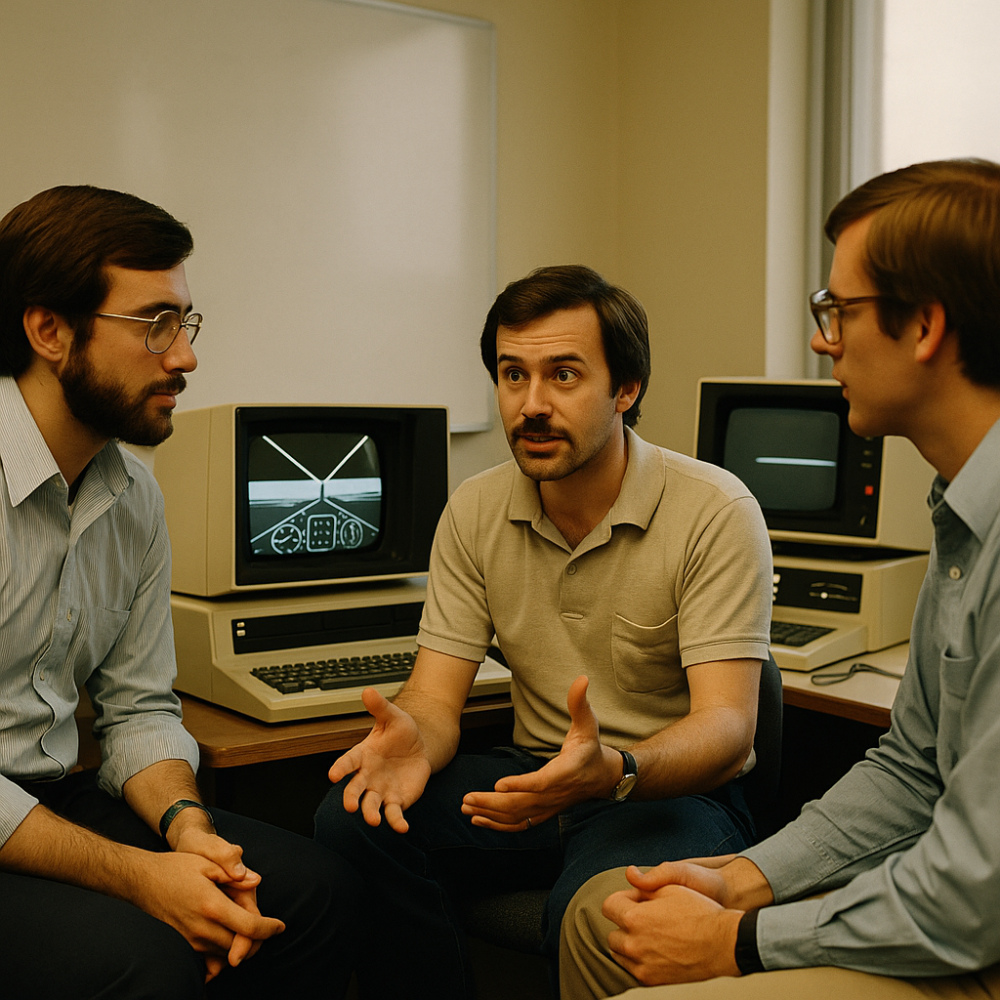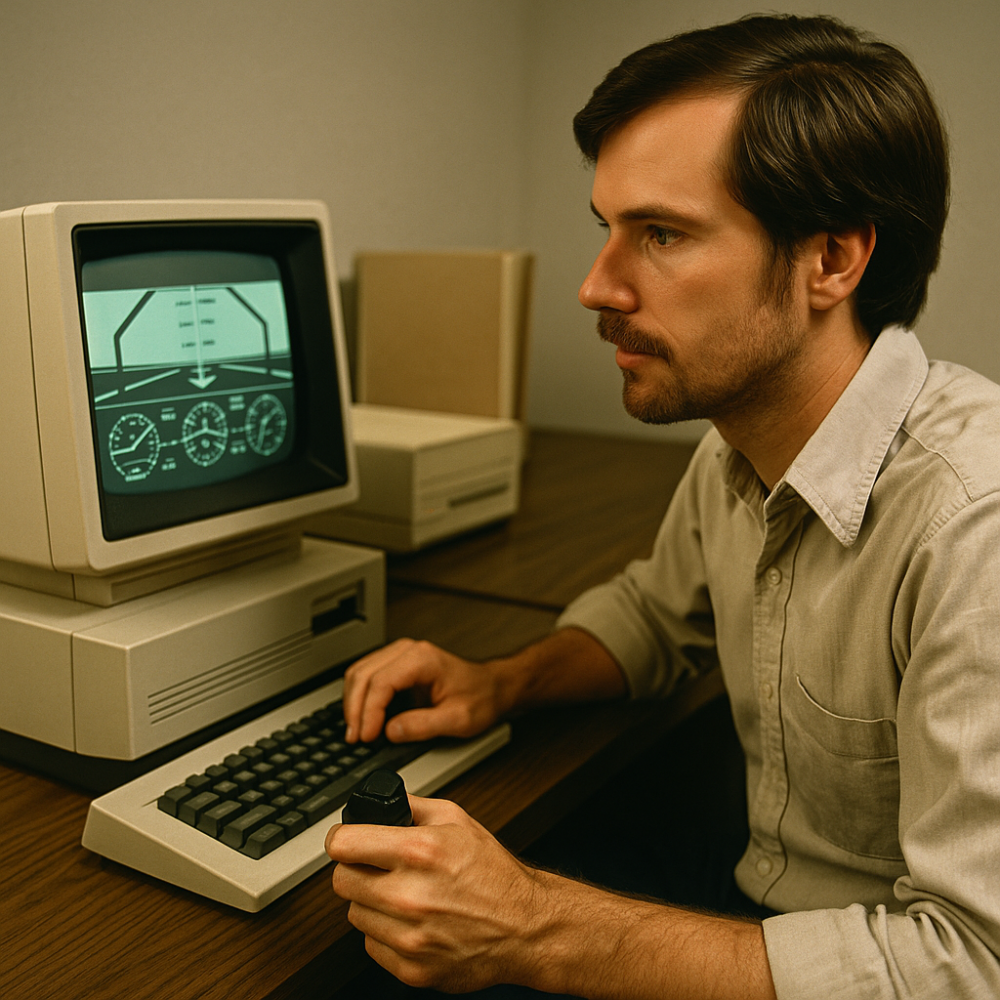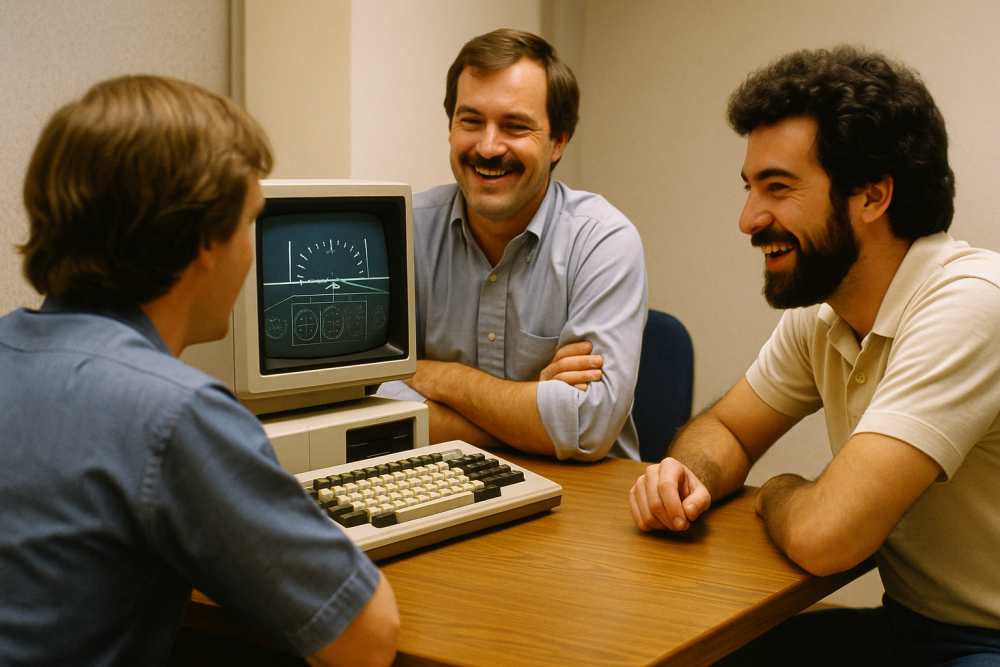
Imagine it’s the 1970s. Tech is in its infancy, but the spirit of innovation is buzzing. Somewhere in this landscape of new possibilities and clunky machines, a few passionate tech pioneers were daring to dream big. They wanted nothing less than to recreate the magic of flight on screens that could barely handle pixelated images.
In this fictional interview, we dive into the minds of these early developers. Inspired by figures like Bruce Artwick, these visionaries are the stuff of legend in the flight simulator world. With basic tools and sheer will, they set the stage for what would become a staple in both gaming and pilot training circles.
Before getting into the nitty-gritty, let’s set the scene. Personal computers were just entering homes, a novelty exciting enough on its own. Now, imagine turning that machine into a cockpit. This wasn’t about mimicking games existing at the time; it was about creating something entirely new—digitally soaring through the sky when the idea was barely imaginable to most.
Our ‘interviewees’ will transport us back to this period of rapid technological advancement and creativity. Through our chat, we’ll explore the inspirations, challenges, and milestones that marked the journey of early flight simulators. It’s a tale of passion meeting persistence and how determination can defy technical limitations.
Get ready to explore a world where the impossible started becoming possible. Fasten your seatbelts as we prepare to meet the minds that made it all take flight.
Soaring with Dreams: The Birth of a Vision

Listen as our trailblazers reminisce about their journey from the ground up. What would spark someone to try virtual flight on machines with the computing power of a modern toaster? Turns out, passion is a major thrust here.
Below is an example of what might be included in such an interview, capturing the voice and vision of those early pioneers:
Q: What inspired you to build a flight simulator when no one else was doing it?
A: “Honestly, I couldn’t wait to replicate the experience of flying,” says one developer, eyes lighting up. “Aviation has always held a special place in my heart. I wanted to share that magic with others in a way that was interactive and engaging.”
Q: How did you stay motivated with such limited technology at the time?
A: “We didn’t have flight sims to look at back then,” another developer explains. “It was purely the dream of watching something fly across a screen—a digital leap of imagination. That dream kept us going.”
Q: Was this just a hobby project at first?
A: “It was never just a hobby,” another voice adds. “Turning that imagery in my mind into something you could see and control was an amazing feeling. That journey from idea to execution—pure thrill.”
Their stories underscore how passion and innovation can beautifully intersect, changing how people interact with technology. This endeavor was more than a flight simulation; it was a testament to dreaming big, embracing challenges, and charting new territories.
📚 Want to learn more about how to start your own journey? Check out our guide: Getting Started With Flight Simulation: A Step-by-Step Guide.
Navigating Turbulent Skies: Challenges of Early Development

Ever tried to build a spaceship with nothing but duct tape? That’s how tackling technology felt back in the day for these pioneers. Crafting early flight simulators was every bit the adventure you might expect with 70s and 80s hardware.
Q: What kind of limitations did you face with the hardware?
A: “We were working with what felt like digital pebbles,” one developer recalls with a chuckle. “The graphics were rudimentary, and memory was a constant battle. Every pixel had to count.”
Q: How did you get creative with such strict limitations?
A: “If we wanted smooth motion, we had to be really clever,” another voice adds. “We’d innovate workarounds that they’d teach as technical feats today.”
Q: What stands out in your memory from those early problem-solving days?
A: “I remember staring at code for hours, figuring ways to make things work that shouldn’t have,” one developer reminisces. “It was like figuring out a new language—a new way to think about what computers could do.”
Let these insights be a reminder: challenges often cloak opportunities. For anyone tackling a big tech project now, consider adopting that same fearless creativity and relentless pursuit. Just like these pioneers, pushing against boundaries might just become your stepping stones to breakthroughs.
🎮 See how today’s simulators compare in our post: Top 10 Flight Simulator Programs Compared.
From Concept to Cockpit: Team Dynamics and Milestones

Early flight sim development wasn’t always a solo show. While many picture a lone coder in a dimly lit room, the truth often had a few more hands on deck.
Q: Were these early projects team efforts or solo endeavors?
A: “We were a tight-knit bunch back then,” one producer notes. “Everyone brought something to the table, and every breakthrough felt like a collective victory.”
Q: What was it like when you finally saw your sim come to life?
A: “When we finally got our first real-time flight sim working, it was a party in the office,” another developer remembers. “We cranked the flight sound effects and just basked in what we’d pulled off.”
Q: How did collaboration help bring the vision together?
A: “There was this energy,” one team lead says, “a sense that we were crafting the future of digital entertainment. That shared mission kept us going, even when we faced setbacks that seemed insurmountable.”
Their journey holds a lesson: collaboration isn’t optional in groundbreaking tech—it’s a requirement. Working with others turns ideas into realized dreams. So, as you put your team together today, harness the power of shared vision and innovation.
🧑💻 Visit FlightGear – an open-source simulator that thrives on community collaboration.
Glimpses of the Future: A New Horizon

Flight simulators have come a long way from those early days of pixels and basic physics. For the pioneers, watching this evolution has been nothing short of astonishing.
Q: What’s your reaction to how far flight sims have come?
A: “Back then, we never dreamed it could get this realistic,” one developer admits, marveling at today’s photorealism and sophisticated dynamics.
Q: What modern features would’ve excited you the most back then?
A: “The level of immersion people can create today is insane,” one excitedly shares. “VR technology, environmental detail—it’s like you’re actually there! The potential is endless.”
Q: Do you still feel that same passion today?
A: “Imagine a sim where AI pilots learn and adapt like humans,” suggests another veteran developer. “That kind of innovation still excites me. We dreamed big because we loved flying, and that love should drive ideas even now.”
Their words echo a timeless truth: innovation is a flight fueled by passion and a vision for possibilities. Whether you’re creating cutting-edge simulations or developing new algorithms, keep dreaming as these trailblazers did. Your cockpit, whatever form it takes, awaits.
🚀 Curious about future sim tech? Learn more about what’s coming in Microsoft Flight Simulator 2024.
✈️ Keeping the Legacy Alive: Your Flight Sim Journey Starts Here
As you’ve seen through the voices of early pioneers, the story of flight simulation is one of vision, grit, and passion. What began as a dream coded in bits and pixels has grown into an immersive experience enjoyed by hobbyists, pilots, and tech lovers around the world.
Now it’s your turn to climb into the virtual cockpit.
Whether you’re just discovering the world of flight simulation or already knee-deep in your setup, there’s always more to explore, tweak, and experience. From hardware choices to simulator software, flight plans to VR gear—the skies are yours to navigate.
🛫 Ready to take off?
Start your own adventure with our Getting Started With Flight Simulation Guide —perfect for beginners, returning simmers, or anyone curious about joining this soaring digital revolution.
And if this article inspired you, be sure to check out our latest community stories, gear reviews, and historical deep dives. You never know where your next virtual flight might take you.
